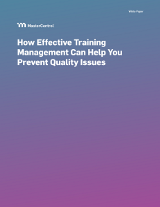
GxP Lifeline
Making Virtual Reality a Component of Your GxP Compliance Training Curriculum

Medical device organizations are at the forefront of industries that are continually evolving their already complex manufacturing processes to drive higher quality products in a more efficient manner. These organizations spend considerable resources – money, time, facilities, products – training their employees and suppliers to ensure GxP compliance in this challenging environment. Unfortunately, as medical technology continues to evolve and supply chains become more complicated, development of effective training modules becomes harder. The lack of appropriate, detailed training on newer, more complex technologies and processes can lead to improper execution of standard operating procedures (SOPs) and be a major factor in a company’s ability to maintain compliance. These training gaps have the potential to result in warning letters, shutdown of manufacturing lines, product holds, product recalls, fines, and other outcomes detrimental to a medical device organization.
To help ensure sufficient GxP compliance training, while also addressing the demand for increased operational productivity and efficiency and higher quality medical device products, companies are turning to virtual reality (VR) training solutions to augment their current GxP compliance training curricula. With the addition of VR training modules to complement existing instructor-led and computer-based training programs, organizations are better equipped to address their ongoing workforce and GxP compliance training challenges. VR enables them to recognize higher training effectiveness through greater knowledge retention, improved safety, reduced scrap during the manufacturing process, increased proficiency, and overall lower training costs – from recruiting to onboarding to upskilling – all while also preserving expert knowledge from aging workers.
Virtual Reality Training vs. Legacy Training Techniques
A PWC study, “The Effectiveness of Virtual Reality Soft Skills Training in the Enterprise,” shows that employees completed VR training programs four times faster than in-person training and 1.5 times faster than e-learning. In addition, a separate article appearing in Fortune, “3 Ways Virtual Reality Training is Producing Better Outcomes,” states that VR training results in learning retention rates of up to 80% one year after training, compared to 20% just one week after traditional training. This is considerable given the high degree of recurring training/certification necessary for GxP compliance training management.
In addition to efficiency and knowledge retention, VR training methods allow employers to evaluate a trainee’s ability to perform tasks in a very specific, and lower-risk, environment instead of the real environment, such as working in a clean room. Knowing their capabilities before they are put into a real-world situation allows for quicker recognition of any knowledge gaps and the reduction of critical errors, often caused by lack of experience. By increasing the efficacy of training and providing more opportunities to practice tasks, the odds of costly human error as well as safety and environmental hazards are greatly reduced.
Studies have shown many other potential advantages of VR training, including:
- Locational Awareness: VR allows users to acquaint themselves with a work environment before ever setting foot inside it, providing a level of familiarity when on the job work begins without the assumption of risk.
- Knowledge Transfer: Given the skills gap and continued need for requisite training to maintain GxP compliance that the industry is facing, VR can help bridge the generation gap by capturing the historical knowledge of the most experienced generation of employees. In addition to knowledge conservation, VR is an enticing recruiting tool for employers to utilize in attracting top talent.
- Recording and Playback: In-the-moment feedback is crucial to training success. Because the training takes place in a digital environment, each session can be recorded and replayed for analysis and feedback, which helps trainees learn from their mistakes, while trainers can evaluate performance in a way that directly reflects the work.
- Hazardous Scenario Simulation: VR allows trainers to introduce simulations that could otherwise be impractical or dangerous. VR provides important hands-on experience without the risk and costs associated with real-world learning.
- Improved Engagement: VR fully engages the senses, preventing an employee from being distracted by outside influences and thus maximizing learning engagement and retention.
- Unlimited Use: Once a VR training module has been created, it can be reused, greatly extending the potential for training and knowledge acquisition, while at the same time reducing the time and cost of off-site training.
Potential VR Training Use Cases
There are common use cases across many industries where VR training is being used, which would also be applicable to GxP compliance training, including:
- New employee onboarding.
- Recertification courses.
- Facility and working environment familiarization.
- Equipment location and identification.
- Emotional evaluation (testing for fear of heights, claustrophobia, motion sickness, etc.).
- Standard operating procedures.
- Hazard identification.
- Inspection procedures.
- Maintenance procedures.
- Emergency response procedures.
- Safety and compliance training.
- Skills and environment screening.
Potential candidates for VR training more specific to the life sciences and medical device industry include:
- Clean room environments.
- Personal protective equipment (PPE).
- Laboratory practices.
- Product-specific manufacturing skills.
- Sterilizations and cleaning.
- Container closure and packaging.
Currently, innovative leaders are integrating VR into their enterprise’s overall training curriculum. As the technology becomes more mainstream, standardized, and affordable, it is expected that much more widespread use of VR in GxP compliance training and other commercial applications will follow.
Free Resource

Enjoying this blog? Learn More.
How Effective Training Management Can Help You Prevent Quality Issues
Download Now